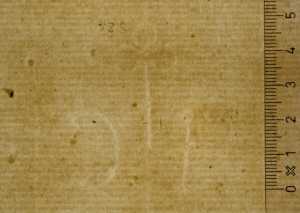Specifications
| Title | Composition Study for the Martyrdom of St Peter and St Paul |
|---|---|
| Material and technique | Black chalk, pen and brown ink, brown wash |
| Object type |
Drawing
> Two-dimensional object
> Art object
|
| Location | This object is in storage |
| Dimensions |
Height 311 mm Width 205 mm |
|---|---|
| Artists |
Draughtsman:
Alessandro Maganza
Previously attributed: El Greco |
| Accession number | S 24 (PK) |
| Credits | Loan Stichting Museum Boijmans Van Beuningen (former Koenigs collection), 1940 |
| Department | Drawings & Prints |
| Acquisition date | 1940 |
| Creation date | in circa 1600-1610 |
| Watermark | Crossbow (42 x 31 mm, near the centre on P5 of 8P, vH, cropped folio sheet), similar to Briquet 733 (Reggio Emilia 1595), but without the countermark, and similar to Piccard Online AT3800-PO-123789 en PPO 9-11-2130 (Arco/Riva di Garda 1593), but without the countermark 3M+trefoil. The same subtype of Crossbow watermark is found in Jacopo Tintoretto's drawing, MBVB, inv. I 75, and in a Maganza drawing in the Fondation Custodia, inv. 4191; Byam Shaw 1983, no. 257, ill. vol. 3, p. 131. The mount contains a countermark Letters IC with a trefoil (48 x 35 mm, on P3 of P9, vH), which could well belong to the drawing sheet as other half of the original plano. [see image] |
| Inscriptions | none |
| Collector | Collector / Franz Koenigs |
| Mark | F.W. Koenigs (L.1023a on removed mount) |
| Provenance | Sir Archibald Alison (1792-1867), Glasgow (in an album); Art dealer Luigi Grassi (1858-1937, L.1171b), Florence (from the album, probably dismembered by him); Franz W. Koenigs (1881-1941, L.1023a), Haarlem, acquired in 1930 (attributed to El Greco); D.G. van Beuningen (1877-1955), Rotterdam, acquired with the Koenigs Collection in 1940 and donated to Stichting Museum Boijmans Van Beuningen |
| Research |
Show research Italian Drawings 1400-1600 |
| Literature | Tietze/Tietze-Conrat 1944, pp. 27, 292 under no. 1757 (Maganza?); Wethey 1962, p. 153 (Venetian Mannerist); Byam Shaw 1976, under no. 840; Byam Shaw 1983, under no. 252; Paris 1996, under no. 61; Matarrese 2002, pp. 57, 74, 87, fig. 26; Boschini/De Boer 2008, p. 389, fig. 359 |
| Material | |
| Object | |
| Technique |
Brown wash
> Washing
> Wash
> Drawing technique
> Technique
> Material and technique
|
| Geographical origin | Italy > Southern Europe > Europe |
| Place of manufacture | Vicenza > Veneto region > Italy > Southern Europe > Europe |
Do you have corrections or additional information about this work? Please, send us a message

























